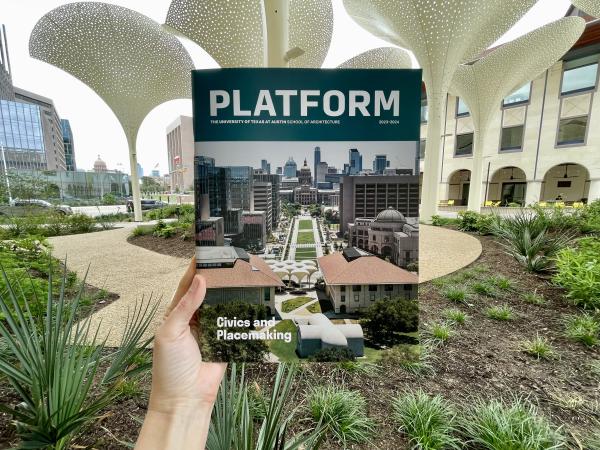2023–2024 Issue of Platform Explores How the UT School of Architecture Contributes to the Creation of Places that Foster Civic Life

Planning and design practices play a significant role in shaping the ways individuals come together, share ideas, and take collective action. Moreover, the ways in which public spaces are planned, designed, constructed, and maintained provide a kind of social infrastructure that supports a community’s pursuit of health, safety, welfare, and its expression of civic aspirations.
In The University of Texas at Austin School of Architecture’s 2023–2024 issue of Platform, “Civics and Placemaking,” essays representing every discipline housed within the school feature examples of how its programs, faculty, students, and alumni contribute to the creation of places that foster civic life here in Austin and beyond.
Whether it’s research partnerships with the City of Austin—like the Center for Sustainable Design’s Austin Convention Center study or the St. John’s site analysis and scenario development project—research into topics of vital importance like housing affordability and climate justice, or faculty design work that helps give shape to the city, the School of Architecture plays an integral role in expanding opportunities and implementing solutions to make our cities and communities more vibrant, healthy, and inclusive.
“Because design is connected to complexity—systems, contexts, cultures, and histories—the integrity of many disciplines come together, with placemaking solutions arising from their collaboration and the specificity of the surroundings,” said Heather Woofter, Dean of the School of Architecture. “Civic life requires a relational perspective, where ‘building’ includes tending to existing spaces, activations that anticipate and test future community-based projects, and forums that encourage difficult conversations to bring various stakeholders together to imagine an accessible and vibrant public sphere.”
The essays within this year’s magazine highlight examples of how this work takes place across disciplines, geography, and scales. Contributors draw upon their disciplinary knowledge and expertise, to consider public space through different lenses and contexts.
● “Water in Cities,” an essay by Associate Professor Michael Holleran, considers public space through the lens of water, exploring the systems that make and shape cities, and the expressions of water in landscape and culture.
● “Mapping the Jaguar Corridor: A Radiography of Urbanization” by Assistant Professor of Practice Juana Salcedo looks at the ways we make space for and through nature by looking at the interconnections, entanglements, and frictions between the process of urbanization and the territory of the jaguar.
● “In Support of Transgressive Practices: Cultivating New Landscape Imaginaries” by Assistant Professor Maggie Hansen explores how landscape architects can shape social and ecological relationships by embracing transgressive practices that exhibit a deep commitment to place.
● “The Civics of a Just Transition,” by Community and Regional Planning Associate Professor Michael Oden and Assistant Professor Miriam Solis, illuminates a recent research effort that aimed to integrate sustainable placemaking with the drive to expand climate justice and the green economy.
● “Multispecies Lounge,” a temporary public art installation created by Associate Professor Nerea Feliz with her collaborator Joyce Hwang, considers how nature and the built environment can co-exist in new ways to improve urban public spaces.
● “Plume,” a public art piece by Associate Professor Kory Bieg and Associate Professor Clay Odom, translates a digitally conceived prototype into a permanent, site-specific architectural work that dynamically interacts with its urban context.
● “Placemaking: The Role of Historic Preservation and Building Documentation in Creating Inspiring Public Spaces” by Associate Professor Benjamin Ibarra-Sevilla highlights placemaking work by the School of Architecture’s Historic Preservation Program in some of our country’s national parks.
● “Architecture is a Team Sport,” an essay by Professor Larry Speck, emphasizes the importance of collaboration in placemaking as he details the multi-faceted teams behind the creation of the State of Texas’ new Capitol Mall.
● “Ripples of Hope,” excerpted from Professor of Practice Coleman Coker’s new book Environmental Activism by Design, co-authored with Sarah Gamble, reflects on how designers and educators can make meaningful changes toward more just and sustainable places and communities.
Published annually, Platform investigates the intersections of the School of Architecture’s research, practice, and teaching and how these extend through the school’s broader community. This year’s issue captures a trace of the school’s intention to link a range of academic pursuits to the public good, considering how this work impacts and shapes the world around us.
For more information and to read the full issue online, visit www.soa.utexas.edu/publications/platform/civics-and-placemaking

